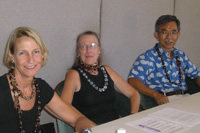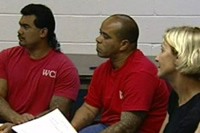 Lorenn Walker, Kat Brady and Ted Sakai speak about An unusual program developed in Hawaii is helping inmates learn new skills, reconnect with their loved ones and prepare for life outside the prison walls.
Lorenn Walker, Kat Brady and Ted Sakai speak about An unusual program developed in Hawaii is helping inmates learn new skills, reconnect with their loved ones and prepare for life outside the prison walls.The Restorative Circle Project, which began at Waiawa Correctional Facility on the island of O’ahu, brings inmates together with the people they have wronged to find ways to repair the harm, explore forgiveness and make plans for their transition back into the community.
The project is one of two restorative justice prison initiatives launched by Lorenn Walker of Hawaii Friends of Civic and Law Related Education. In addition to the Restorative Circle project, Walker also offers the inmates restorative justice facilitator training, a 12-week program that teaches communication and conflict resolution skills.
“I’m on a mission to help transform the justice system and make it healthy and healing,” said Walker, a public health educator and former trial lawyer who has worked in many aspects of the legal system, from family court to representing the Hawaii state prison system as deputy attorney general.
Walker was drawn to her work by what she sees as a compelling need. “We have a huge prison problem in the United States,” she said. “We have the highest rate of incarceration in the world. I don’t believe Americans are worse than any other people. Clearly, there is a problem with the system.”
Hawaii, a state with a population of less than a million, has about 6,000 people in prison and spends more than $200 million a year on corrections. Research indicates that within two years of their release, about half of all inmates will be back in prison. “We need a transformation,” Walker said.
And a transformation is exactly what she tries to bring about through her restorative programs.
Both initiatives use a “solution-focused approach,” which emphasizes the positive aspects of the inmates and their lives. For example, facilitators ask inmates to reflect on their progress and accomplishments, such as staying sober, how they have achieved these positive goals and what they need to do to maintain them. The approach focuses on helping inmates determine what they want and how to achieve it, rather than dwelling on problems.
Walker says the solution-focused approach is “consistent with the theory of desistance, which looks at how offenders abstain from crime and stay out of prison. It’s a pretty complex theory, but one thing for sure is that offenders who stay crime free have positive self-identities, and that’s something the solution-focused approach achieves.”
Inmates also are introduced to the basic restorative justice questions: Who was affected by the wrongdoing? How were they affected? And what might be done to repair the harm? These questions, explored through both Restorative Circles and the facilitator training, shift inmates’ focus away from themselves and toward their victims.
As far as Walker knows, the programs are unique. “I don’t think anyone else is doing quite what we’re doing,” she said.
In the Restorative Circle project, inmates participate in a circle with a facilitator and individuals of their choosing, often family members. They also invite a prison representative, typically a counselor. Each inmate chooses how to open his circle, such as with a poem, song or prayer. The event lasts three hours and includes a discussion of the inmate’s strengths, progress and what needs to be done to maintain a crime-free life; who has been affected by their past behavior and how; and how he or she might repair the harm. The group also discusses the inmate’s future and brainstorms resources to meet needs such as housing, employment and transportation. Family members may volunteer help, such as the use of a vehicle or a place to stay. The inmate then makes a plan for his or her transition.
 Inmates participate in a restorative justice facilitator training at Waiawa Correctional Facility, on O’ahu, Hawaii
Inmates participate in a restorative justice facilitator training at Waiawa Correctional Facility, on O’ahu, Hawaii
For Edwin Kansana, a former methamphetamine addict, the Restorative Circle project provided a life-changing opportunity. After spending several years in prison for theft, Kansana took part in a circle as he prepared for release in 2006. “I needed to share things that I was building up inside of me, and the only way I could do that was to confront the victims of my past crimes,” he said. Apologizing to his family provided an opportunity for healing. As for his family members, “they were seeing a part of me they could never see before. I never could speak and share feelings.”
Now holding a job and teaching a Hawaiian language class in addition to being a father to his young daughter, Kansana is doing well. When problems do crop up, he handles them better than he used to. “I have more courage to approach the problem instead of hiding from the problem,” he said. “I learned that if I hide from the problem, the problem is always still going to be there.”
Kansana accomplished within a year most of the goals established in his five-year plan. He said his family appreciates the difference in him: “They see that I do things totally different from what I used to do, so they’re happy for me.” Family members also still come together for exchanges similar to the circle process. “We all consider that a really positive thing,” Kansana noted.
“I feel really blessed being in this program, and things are really coming together,” he concluded. “I don’t quit, and I always look forward. I know I’m on the right track. I believe this program was a really big part of that.”
Since the circle project began in 2005, more than 200 people have participated in Restorative Circles, and 100 percent of them rated the overall experience as positive. Only one participant, an inmate’s ex-wife, found something negative about the process, which concerned learning new information about her ex-husband. Inmates from both the Waiawa facility and the Women’s Correctional Center in Kailua have participated in Restorative Circles.
About 40 inmates also have participated in Walker’s 12-week facilitator training on “Solution-Focused Problem Solving and Restorative Justice Approaches,” designed to teach self-control and getting along with others. Inmates meet weekly for group sessions, led by Walker and a colleague, that focus on building listening and communication skills, as well as resiliency and forgiveness. They read and discuss Man’s Search for Meaning, by Viktor Frankl; conduct listening and role-playing exercises; and participate in “Modified Restorative Circles” with other inmates and counselors.
So far, two groups have gone through the training, with another planned for this autumn. “It’s been really transformative for the inmates,” Walker said, “and for us, too.”
Ted Sakai, a former warden at Waiawa and former state director of public safety, has observed the restorative process in action at his prison. “I was blown away by the circles,” he said. “The emotion was just overwhelming. After the first one, I told Lorenn, ‘Next time, bring a lot of Kleenex.’” Sakai believes that he has witnessed many emotions being expressed for the first time, and a lot of healing begun.
Sakai sees a definite need for programs like Walker’s. “Almost all the inmates we have locked up in any system are going to go home someday,” he pointed out, and research shows nurturing relationships “on the outside” to be important to successful reentry. His conclusion: “We’ve got to help inmates connect to family.” Having worked in the prison system for 30 years, however, Sakai knows the barriers to such connection. For one thing, there’s the separation created by incarceration. For another, family members are sometimes the direct victims, and almost always the indirect victims, of the inmate’s crimes. “There are a lot of feelings that are unresolved,” he said. “You’ve got to address these things before the inmate goes out and tries to rejoin the family.”
Restorative Circles, in Sakai’s view, are a good start. “The beauty of the circle was that in a relatively short period of time, all of these issues came out…and because of facilitation, [they were] brought out in a relatively controlled and really focused manner,” he said. “I think because of that, this can be a very important reentry program.”
“If we can get every inmate hooked up with some nurturing relationship outside,” he added, “we would have so many more successes out there.”
Sakai, like Walker, would like to see the restorative programs expand. Thanks to a law recently passed by the Hawaii legislature, that’s likely to happen.
The “Community Safety Act – Comprehensive Offender Reentry System” provides funding to continue and expand the Restorative Circle Project. The law, which allocates $202,000 to restorative programs for 2007-08, will continue the existing project in the men’s and women’s prisons and expand the program statewide, making it available to all Hawaii prison facilities.
The law represents a fundamental shift in Hawaii’s correctional system, said Kat Brady, coordinator of Community Alliance on Prisons and a coauthor of the bill. “It changes the philosophy of the correctional system from punishment to rehabilitation and reentry,” she said. “It also acknowledges that restorative justice is an effective reentry strategy.”
Brady and Walker are now working to ensure that the law’s measures are enacted and the promised funding materializes. Brady is hopeful that more inmates soon will enjoy the opportunity that Kansana had.
“I would love to see more jurisdictions embrace restorative justice,” she said. “That, to me, is the root of building community, reducing crime and creating happy people.”

